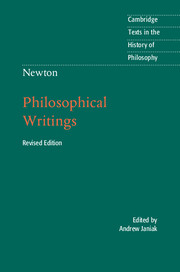Book contents
- Frontmatter
- Contents
- Acknowledgments
- Introduction
- Chronology
- Further reading
- Note on texts and translations
- I “New Theory about Light and Colours”
- II Correspondence with Robert Boyle [1679]
- III De Gravitatione [date unknown]
- IV The Principia [1687, first edition]
- V “An Account of the System of the World”
- VI Correspondence with Richard Bentley [1691–3]
- VII Correspondence with G. W. Leibniz [1693/1712]
- VIII Correspondence with Roger Cotes [1713]
- IX An Account of the Book Entitled Commercium Epistolicum [1715]
- X Queries to the Opticks [1721]
- Index
- References
I - “New Theory about Light and Colours”
Published online by Cambridge University Press: 05 August 2014
- Frontmatter
- Contents
- Acknowledgments
- Introduction
- Chronology
- Further reading
- Note on texts and translations
- I “New Theory about Light and Colours”
- II Correspondence with Robert Boyle [1679]
- III De Gravitatione [date unknown]
- IV The Principia [1687, first edition]
- V “An Account of the System of the World”
- VI Correspondence with Richard Bentley [1691–3]
- VII Correspondence with G. W. Leibniz [1693/1712]
- VIII Correspondence with Roger Cotes [1713]
- IX An Account of the Book Entitled Commercium Epistolicum [1715]
- X Queries to the Opticks [1721]
- Index
- References
Summary
19 February 1672
Sir,
To perform my late promise to you, I shall without further ceremony acquaint you, that in the beginning of the year 1666 (at which time I applied myself to the grinding of optic glasses of other figures than spherical) I procured me a triangular glass prism, to try therewith the celebrated phenomena of colours. And in order thereto having darkened my chamber, and made a small hole in my window shuts, to let in a convenient quantity of the sun’s light, I placed my prism at its entrance, that it might be thereby refracted to the opposite wall. It was at first a very pleasing divertisement, to view the vivid and intense colours produced thereby; but after a while applying myself to consider them more circumspectly, I became surprised to see them in an oblong form; which, according to the received laws of refraction, I expected should have been circular.
They were terminated at the sides with straight lines, but at the ends, the decay of light was so gradual, that it was difficult to determine justly, what was their figure; yet they seemed semicircular.
Comparing the length of this coloured spectrum with its breadth, I found it about five times greater; a disproportion so extravagant that it excited me to a more than ordinary curiosity of examining, from whence it might proceed. I could scarce think, that the various thickness of the glass, or the termination with shadow or darkness, could have any influence on light to produce such an effect; yet I thought it not amiss to examine first these circumstances, and so tried, what would happen by transmitting light through parts of the glass of diverse thicknesses, or through holes in the window of diverse bignesses, or by setting the prism without so that the light might pass through it, and be refracted before it was terminated by the hole: but I found none of these circumstances material. The fashion of the colours was in all these cases the same. …
- Type
- Chapter
- Information
- Newton: Philosophical Writings , pp. 1 - 14Publisher: Cambridge University PressPrint publication year: 2014

